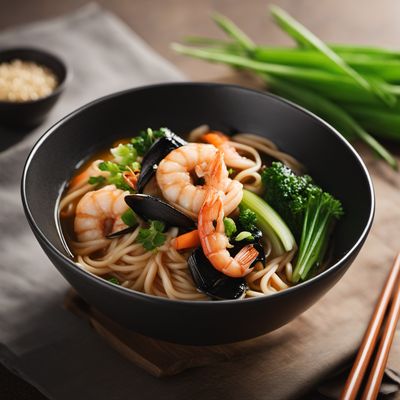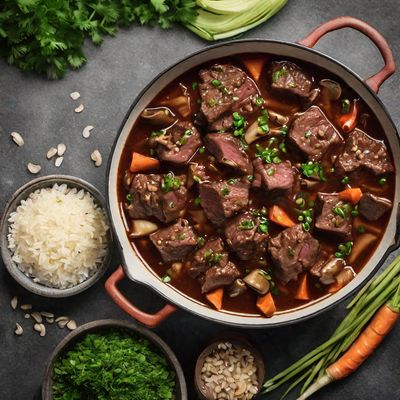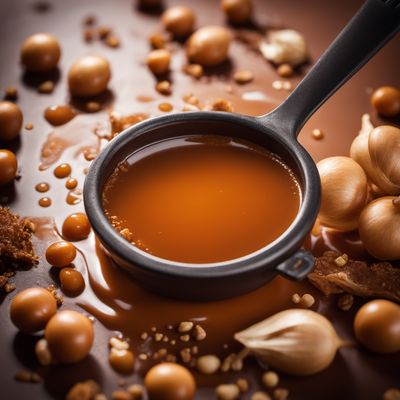
Ingredient
Gravy thickener
The Secret to Perfectly Thickened Gravy: Unveiling the Power of Gravy Thickeners
Gravy thickeners are essential ingredients used to achieve the desired thickness and texture in gravies. They come in various forms, including flours, starches, and gums, and are added to the gravy during the cooking process. These thickeners work by absorbing the excess liquid and forming a gel-like substance, resulting in a smooth and velvety texture. They also contribute to the overall flavor and mouthfeel of the gravy, ensuring a satisfying dining experience.
Origins and history
The use of gravy thickeners can be traced back to ancient civilizations, where cooks discovered the need for a thickening agent to enhance the texture and consistency of sauces and gravies. Over time, different cultures developed their own methods and ingredients for thickening gravies, such as using wheat flour, cornstarch, or arrowroot. Today, gravy thickeners are widely used in culinary traditions around the world.
Nutritional information
Gravy thickeners are primarily used in small quantities, so their nutritional impact is minimal. They are typically low in calories and do not contribute significant amounts of nutrients.
Allergens
Some gravy thickeners, such as wheat flour or cornstarch, may contain gluten, making them unsuitable for individuals with gluten sensitivities or celiac disease. It is important to check the label or choose gluten-free alternatives if necessary.
How to select
When selecting a gravy thickener, consider the desired outcome and the specific dietary needs. For a traditional gravy, wheat flour or cornstarch can be used. If gluten-free or low-carb options are preferred, alternatives like arrowroot or xanthan gum can be chosen. Look for high-quality brands and check for any additional ingredients or additives that may affect the flavor or texture of the gravy.
Storage recommendations
Gravy thickeners should be stored in a cool, dry place, away from moisture and direct sunlight. It is important to seal the packaging tightly to prevent clumping or moisture absorption. Follow the manufacturer's instructions for specific storage recommendations, as some thickeners may have different requirements.
How to produce
Gravy thickeners are typically produced on a large scale by food manufacturers. However, amateur cooks can easily make their own thickening agents by combining flour or starch with water or broth to create a slurry, which can then be added to the gravy.
Preparation tips
To use a gravy thickener, it is important to follow the recipe instructions carefully. Typically, a small amount of the thickener is mixed with a liquid, such as water or broth, to create a slurry. This slurry is then added to the gravy while it is simmering, stirring continuously until the desired thickness is achieved. It is important to avoid adding too much thickener at once, as it can result in a lumpy or overly thick gravy. Adjust the amount of thickener based on personal preference and the desired consistency.
Substitutions
Suitable substitutes for gravy thickeners include cornstarch, arrowroot, tapioca starch, or even a roux made from flour and fat. These alternatives can be used in a similar manner to achieve the desired thickness and texture in gravies.
Culinary uses
Gravy thickeners are primarily used in gravies, sauces, and soups to achieve a smooth and thick consistency. They are also commonly used in dishes such as stews, pot pies, and casseroles to enhance the overall texture and mouthfeel.
Availability
Gravy thickeners are widely available in grocery stores, supermarkets, and online retailers, making them easily accessible to home cooks and professional chefs alike.
More ingredients from this category
Recipes using Gravy thickener » Browse all

Chinese Aristocrat Mushroom Velouté
Silken Mushroom Elixir: A Chinese Aristocrat Delight

Canadian-style Seafood Udon
Oceanic Delight: Canadian Seafood Udon

Slow-Braised Pork Hock in Soy-Ginger Glaze
Ginger-Glazed Pork Hock Delight

Molecular Gastronomy Garlic Soup
The Molecular Transformation of Spanish Garlic Soup

Mongolian-style Spiced Lamb Stew
Savory Mongolian Lamb Delight

Nimono - Japanese Simmered Dish
Umami Delight: Simmered Japanese Comfort

Beef & Broccoli Croatian Style
Brokula s Govedinom - Croatian Beef & Broccoli Delight

Sichuan-style Beef Bourguignon
Spicy and Fragrant Sichuan Beef Stew

Korean-style Beef Bourguignon
Bulgogi Bourguignon: A Fusion of French and Korean Flavors

Leonese Tarragon Chicken
Savory Tarragon Chicken Delight

Khoresh Karafs with Persian Herbs and Lamb
Herb-Infused Lamb Stew: A Taste of Persian Delight

Chinese-style Bouillabaisse
Sichuan Spiced Seafood Stew

